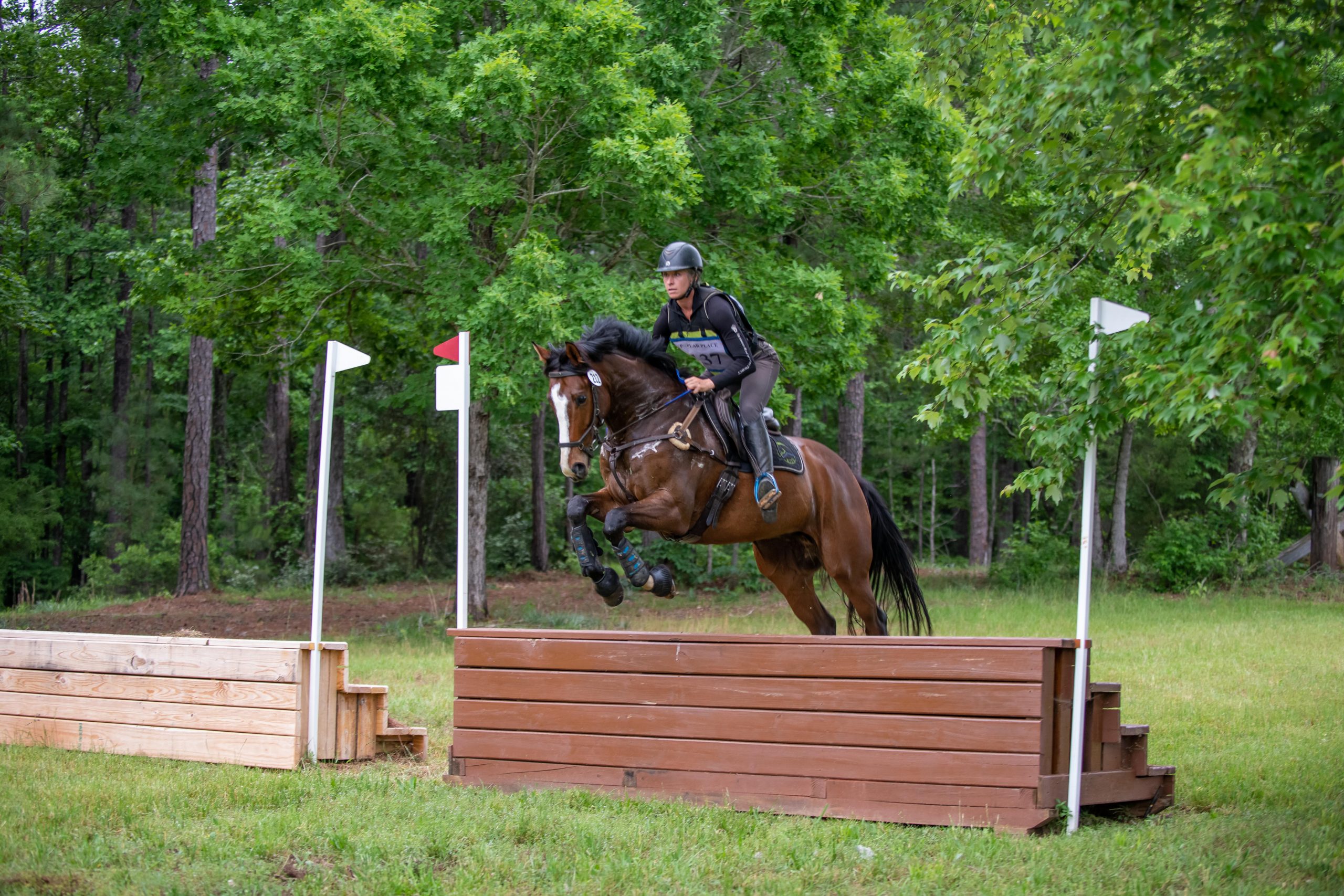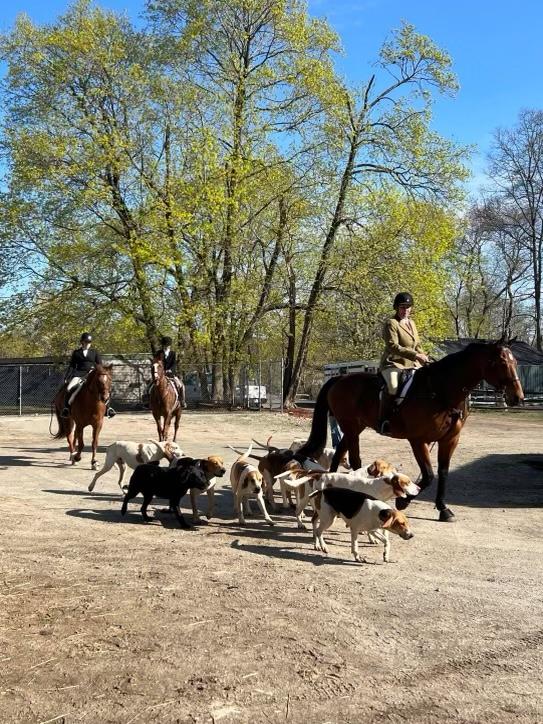
Thoroughbred Logic: All the Potential
“[T]here are the [horses] that might not have the most impressive height, might not have a pedigree with the most known sires, might not have perfectly straight legs, or might not be the easiest ride between the ears … Those are the horses that I find exciting. They’re the diamond in the rough horses.”
Welcome to the next installment of Thoroughbred Logic. In this weekly series, Anthropologist and trainer Aubrey Graham, of Kivu Sport Horses, offers insight and training experience when it comes to working with Thoroughbreds (although much will apply to all breeds). This week, come along for the ride as Aubrey offers her logic on recognizing a horse’s potential (whatever that might be) and working toward realizing it.
Sometimes the potential is obvious. The perfect conformation, sweeping gait, and general trainability ooze from the right horses. In the right hands, those horses might go far — like top of the sport far — or they might make the perfect ammy mount (ahem, Louis — Unbridled Bayou). Either way, their looks (and hopefully their brains) are there. They are the obvious ones. And they regularly break the internet.

Louis (Unbridled Bayou), an obvious horse of all the potential, looks, and movement, making easy work of the Novice course at Poplar. Photo by Cora Williamson.
Then there are the ones that might not have the most impressive height, might not have a pedigree with the most known sires, might not have perfectly straight legs, or might not be the easiest ride between the ears. But sometimes, there is still something about these horses and you just end up “knowing” that there’s something special in there. Those are the horses that I find exciting. They’re the diamond in the rough horses. The ones where with a little time, dedication, and direction, that talent is going to find the right outlet and it is going to be amazing.

Wolf (Louisiana Moon) trying his hand at being fancy in dressage at Poplar. Photo by Cora Williamson.
This topic of “potential” came about after Wolf (Louisiana Moon’s) first Starter Three Phase at Poplar last Saturday. Wolf is a warhorse (more than 50 races), who last raced in February of this year — it was his 63rd run. He has been in letdown and light retraining with me since March and has just started putting small courses together and schooling cross country. My goal, because I like this horse a ton, is to get this kid to the Retired Racehorse Project’s Thoroughbred Makeover in October.
At Poplar, Wolf entered the stadium arena, looked at nothing, clicked around and came out on the same canter that he started with. Good Wolf. That said, he also had five rails … at Starter (2’3″). I’m sure there were at least a few folks watching who thought, “Oh man, that one isn’t going to make it as an eventer.” And I don’t blame them. But I left the ring with a round of big pats, and the thought that “holy hell, this horse is going to be outstanding.”
There is all the talent — I just have a bit of homework.
What Wolf needs is a set of grids and a series of low fences with 9-foot out ground poles in front so that he learns where to put his feet for takeoff. Four of the five poles we dropped were from trying to jump the course from basically underneath the fence. That is a simple training component I can work with. More importantly, what I was paying attention to was his ridability, his bravery, his athleticism and his willingness to try without fully understanding the ask. That he kept working at it and that he got better and better as he made his way through the course tells me all I need to know about him: there is potential. In fact, there is a whole lot of it, packed in a petite plain bay package.

Wolf (Louisiana Moon) figuring out how to manage his footwork to fences near the end of the course at Poplar Place Farm this past weekend. Photo by Cora Williamson.
The notion of potential is a hard thing to nail down, though. Hell, sometimes potential is simply a cruel mistress. A lot of horses have it. But after years of blood, sweat, and tears (and vet bills and calls to your coach), they just don’t pan out. Often they need another job, another pilot. To state the obvious subtext, I suppose it is a hell of a lot like relationships — just minus the vet bills hopefully.
I mean, the last time I had five rails in a stadium round, I didn’t walk out going, “fantastic, this horse is going to be great.” Rather, I walked out knowing there were some seriously big changes that I was going to have to make — none of which I wanted to. They had seemed to have all the potential, but it still was just not going to work out.
With Boomer (Vanderboom Ridge), we yard-saled the Tadpole poles. He inverted and blasted through the rails, scared, coming back to me and trying again only because he has the world’s best brain. I never ran him in another horse trial, never bothered giving Beginner Novice a shot. Instead, I thought long and hard about the round, called the vet and found the hind-end injury that I thought might have been there — an old suspensory injury from racing that was adding pain and stress to his riding career, taking stadium jumping out of the realm of kind options. Fast-forward a few years and Boomer is now the Huntsman’s horse for Myopia Hunt in Massachusetts. I could not be prouder of that giant, goofy kid.

Vanderboom Ridge (right) with Samantha Stevens leading Myopia Hunt. Photo courtesy of Samantha Stevens.
With Forrest (Don’t Noc It) running at Training-level, his five rails told a different story. He was so hard to ride to the fences that it wasn’t worth pushing him harder. While I had hoped his potential was geared towards the upper levels, his brain and his body had other plans. That big goofy red horse has shown off all his skills though as a lesson/lower level lease horse, and general all-arounder. Best part of that: I think he’s happier teaching people how to keep him straight at a plodding trot than chasing the green/blue/red flags.

Forrest (Don’t Noc It) not being super easy to jump around the meters (and my position not helping anyone) back in 2020. Photo by the Kivu Team.
So what makes me think that Wolf and his five rails are any different? Part of it is that I’m pretty sure I know where the error is — and it is in part a training component that is pretty easy to address. Another part of it is that I don’t think that pain is directly involved, and part of it is that when he does get his footwork right, his natural jumping ability is damn impressive. And lastly, a key part of it is how bloody smart this horse seems to be.

Wolf’s smarts show up clearly in his quality footwork and willing forward style on cross country (Shown here headed up the Novice bank to fence combination). Photo by Cora Williamson.
But honestly, what I “know” about his potential is really just about trusting my gut. And after years of doing this, my gut tells me that this horse might take a bit to develop, but he is undoubtedly going to be something special.
It is the same feeling I have with Rhodie (Western Ridge) my other hard-to-ride but superstar plain bay. I have nearly given up on that horse about six times. He has crashed me into arena rails, through jumps, and made getting around a full course in control nearly impossible. But I have taken him to my coach and other 5* eventers to clinic and lesson, and there is consensus — the potential is there, it just needs to be correctly developed.

Rhodie (Western Ridge) completing a clear, scope round at Training last Saturday. Photo by Cora Williamson.
They’re looking at his athleticism, his brain, and his conformation. So am I. And we all know that he’s not going to necessarily win at the lower levels (though we should able to). But he has a shot at the colorful numbers (ahem green, blue and red), if I’m able to ride well enough to get him there. And in that vein, between Wolf’s rides around his first Starter, Rhodie finished his first full Training Level Three Phase on his dressage score and proved that he’s ready to make the leap to recognized shows and to getting out there and moving on up.
With both Wolf and Rhodie, I know that the path to the upper levels is never straight or simple. There will be setbacks, challenges, and maybe all out failure. But both horses, with their confidence, uncanny intelligence and bred-to-run-bloody-fast athleticism, there is so much potential that they’re worth the time, effort and potential heartbreak.
At the end of the day, potential is a relative concept. I am always looking for the potential to get back up into the upper levels. But being able to recognize the potential to be a quiet, ammy-friendly ride, or the potential to be a good hunt horse, or the potential to turn into a horse a kid can grown with, those are all fair and worthy pursuits as well. Until those horses have been given a chance to prove themselves in their job, they too are all full of that gut-trusting potential. And all it takes is for someone to not just “see” the diamond through the coal chunk, but for that someone to be willing to put the time, effort, and heart in to chip away and hone it into existence.






